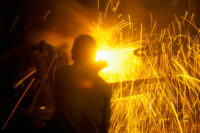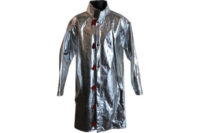
On May 23, 2010, Funny Car Drag Racer Jim Head was speeding down the track in Topeka, Kansas, when an internal engine component in his car failed. The highly flammable, nitro-methane fuel in the engine immediately combusted, completely engulfing the car and its driver in flames for more than 10 seconds. Head was able to maintain control of the car and activate the fire system to extinguish the flames.
Head’s flame-resistant (FR) fire suit served its purpose and protected his body from the heat and flames. His helmet sock, which protects a driver’s face and neck, provided some protection but ultimately failed, allowing the fire to penetrate through a fist-size hole that opened up. Fortunately, Head was wearing a second layer of protection; a FR balaclava under his helmet sock, which protected his skin from the flames. Wearing this additional barrier allowed Head to walk away from one of the worst car explosions in recent NHRA history without even a red mark on his skin.
Whether it’s drag racing at more than 300 mph, skimming molten metal at 3,000 degrees or working on energized switch gear at 38kV, different hazardous activities and environments require different, and often flexible, protective solutions.
When exposure to flame and high heat is involved, safety managers are faced with the critical task of selecting FR clothing that provides the best protection without exceeding budget constraints. Often, these managers are responsible for protecting personnel in multiple hazardous environments.
While standards and requirements for PPE solutions may vary across environments, the goal of all FR apparel remains the same: protect the skin and prevent it from getting burned. Perhaps the most important piece of PPE in achieving this goal is the base layer garment - the last line of defense between flame and heat and bare skin.
Selecting the right base layer
Millions of workers who confront extreme conditions on a day-to-day basis routinely wear a simple cotton T-shirt and briefs as their base “protective” layer. This combination, while inexpensive and permitted under current industry safety standards and regulations, has some serious drawbacks, even if the cotton is chemically treated to be flame-resistant. First, the cotton in these garments absorbs moisture and holds it close to the skin, creating an uncomfortable situation at best and setting the stage for significant steam burns at worst. Also, in an emergency situation, undergarments such as these may actually ignite, resulting in more severe injuries than if the wearer had been wearing no base layer at all.
Base layer clothing predominately made of modacrylic fabrics also meets basic safety requirements for FR garments. These garments off-gas to prevent combustion, but they offer little to no protection against molten metal splash and are prone to break open after brief exposure to flame.
Fabrics comprised of a blend of carbonized fibers offer the highest level of protection and exceed FR apparel testing standards. Base layer garments made of these fabrics are inherently non-flammable; will not burn, melt or ignite when exposed to direct flame; are impervious to molten metal splash and have exceptional electrical resistance. These fabrics are comfortable, dry quickly and wick moisture efficiently, even when worn in extreme conditions.
Lightweight FR knits are used in base layer solutions that cover exposed workers from head to toe, including balaclavas, long- and short-sleeve tops, full-length and boxer-length bottoms, gloves and socks. These products provide consistent protection for workers across a number of hazardous environments, enabling a level of standardization to be achieved. They can also be worn under a variety of primary protection garments or layers.
Layer on protection
Much like outdoor enthusiasts have adopted a layering approach to protection from the elements, safety managers have begun to recognize the benefits of using multiple layers to address exposure to flame and high heat risks.
In the outdoors, outer layers and shells can be easily swapped out based on current weather conditions, but the base layer almost always remains the same in any given season. Similarly, in a hazardous work environment, a comfortable and highly protective base layer forms a solid foundation on top of which other secondary and primary protection layers can be added as barriers against specific dangers (like aluminized coats for reflecting radiant heat, treated materials for shedding hot liquids, triple-layer arc hoods for protecting against arc flash, etc.). The layered approach can be adapted to any situation across multiple applications and industries.
With a layered clothing system, two plus two often equals five when it comes to thermal protection. Thanks to the additional insulation provided by the air trapped between layers, two lighter-weight or lower-rated garments can often provide the same or even better protection when worn together than a single, heavier primary protection layer.
When workers are exposed to extreme conditions involving flame, molten metal, arc flash, or other thermal hazards, primary protection layers will likely break down at some point, allowing the hazard to penetrate to the inner apparel and the body. In these dangerous situations, having a highly protective base layer can provide additional, life-saving seconds to allow the worker to escape without serious injuries.
Layers provide flexibility and comfort
Layering is also a solution in the ongoing battle between protection and comfort. Layering FR clothing prevents employees from having to sacrifice protection for comfort or vice versa. Employees who feel uncomfortable in their PPE will often alter their clothing or even remove protection in order to achieve greater comfort or to perform better on the job. With a layered approach, employees can wear heavier, higher-rated outer gear in extreme-risk situations, and then remove this clothing when the threat of injury is not as great and still be protected by a lighter weight protective base layer.
Greater comfort leads to increased compliance. Increased compliance means safer workers and fewer burn injuries. Fewer burn injuries result in fewer workers’ compensation claims and greater cost savings. Using a quality, protective FR base layer as the foundation of a flexible, layered PPE clothing system saves money and, most important, can save lives.






